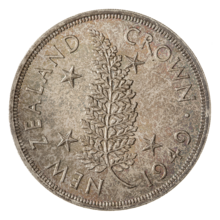
The British crown was a denomination of sterling coinage worth 1⁄4 of one pound, or 5 shillings, or 60 (old) pence. The crown was first issued during the reign of Edward VI, as part of the coinage of the Kingdom of England.
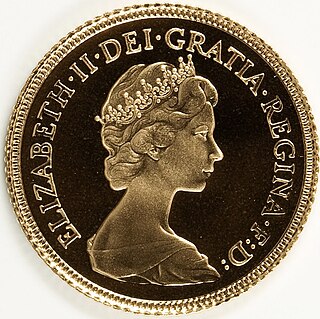
The half sovereign is a British gold coin denominated at one-half of a pound sterling. First issued in its present form in 1817, it has been struck by the Royal Mint in most years since 1980 as a collector's and bullion piece.

The Royal Canadian Mint is the mint of Canada and a Crown corporation, operating under the Royal Canadian Mint Act. The shares of the Mint are held in trust for the Crown in right of Canada.

The pound was the currency of Australia from 1910 until 14 February 1966, when it was replaced by the Australian dollar. Like other £sd currencies, it was subdivided into 20 shillings, each of 12 pence.

The British sixpence piece, sometimes known as a tanner or sixpenny bit, was a denomination of sterling coinage worth 1⁄40 of one pound or half of one shilling. It was first minted in 1551, during the reign of Edward VI, and circulated until 1980. The coin was made from silver from its introduction in 1551 until 1947, and thereafter in cupronickel.
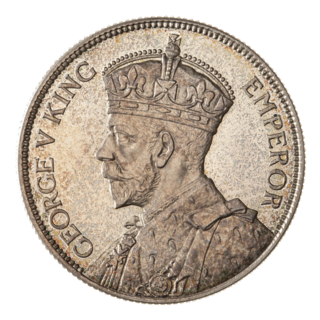
The florin is a coin issued for the New Zealand pound from 1933 to 1965, equal to two shillings or twenty-four pence. The coin features a kiwi on the reverse and the reigning monarch on the obverse. It was introduced in 1933 as part of the first issue of New Zealand pound coinage, due to shortages of British silver coins resulting from the devaluation of local currency relative to the pound sterling. A lengthy design process was further protracted due to differing proposed design motifs between the Royal Mint, supporting a reverse design featuring heraldic ships, and the Gordon Coates–appointed Coinage Committee's proposed kiwi design. This disagreement led to almost a dozen proposed designs and revisions before the finalised issue entered circulation in February 1934. Initially struck in silver by the Royal Mint to replace the previous imperial florin, it was struck in cupronickel from 1947 due to rising precious metal prices. While proposed as the base of a decimalised New Zealand coinage since the 1930s, the florin was ultimately replaced in 1967 by the coinage of the New Zealand dollar.
The coins of the Australian dollar were introduced on 14 February 1966, although they did not at that time include the one-dollar or two-dollar coins. The dollar was equivalent in value to 10 shillings in the former currency.
The coins of the New Zealand dollar are used for the smallest physical currency available in New Zealand. The current denominations are ten cents, twenty cents, fifty cents, one dollar and two dollars. The $1 and $2 coins are minted in a gold colour, the 20c and 50c coins are silver colour and the 10c coin is plated in copper.

The double sovereign is a gold coin of the United Kingdom with a nominal value of two pounds sterling (£2). Rarely issued in the first century and a half after its debut in 1820, it never had a significant presence in circulation. It is now a collector and bullion coin, and has been struck most years since 1980. It features the reigning monarch on its obverse and, most often, Benedetto Pistrucci's depiction of Saint George and the Dragon on the reverse.

The Jubilee coinage or Jubilee head coinage are British coins with an obverse featuring a depiction of Queen Victoria by Joseph Edgar Boehm. The design was placed on the silver and gold circulating coinage beginning in 1887, and on the Maundy coinage beginning in 1888. The depiction of Victoria wearing a crown that was seen as too small was widely mocked, and was replaced in 1893. The series saw the entire issuance of the double florin (1887–1890) and, in 1888, the last issue for circulation of the groat, or fourpence piece, although it was intended for use in British Guiana. No bronze coins were struck with the Jubilee design.
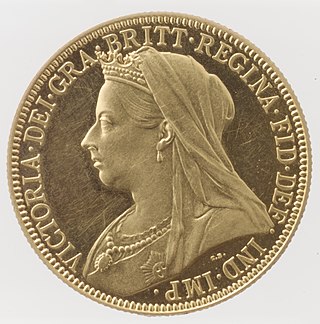
The Old Head coinage or Veiled Head coinage were British coins struck and dated between 1893 and 1901, which featured on the obverse a portrait by Thomas Brock of an aged Queen Victoria wearing a diadem partially hidden by a widow's veil. It replaced the Jubilee coinage, struck since 1887, which had been widely criticised both for the portrait of the Queen, and because the reverses of most of the coins did not state their monetary values. Some denominations continued with their old reverse designs, with Benedetto Pistrucci's design for the sovereign extended to the half sovereign. New designs for some of the silver coinage were inaugurated, created either by Brock or by Edward Poynter, and all denominations less than the crown, or five-shilling piece, stated their values.

The halfpenny was first issued in New Zealand in 1940, seven years after the first introduction of a domestic pound coinage.

The Waitangi crown is a commemorative crown coin struck in 1935 by the British Royal Mint for the Dominion of New Zealand to commemorate the 1840 signing of the Treaty of Waitangi, often seen as New Zealand's founding constitutional document. It was the first five-shilling piece minted of the New Zealand pound and the nation's first coin minted primarily for collectors. Following the rejection of designs by James Berry and George Kruger Gray, Royal Mint designer Percy Metcalfe was commissioned to design the reverse. Design disagreements plagued the production of the crown, and only an extremely small mintage of 1,128 was struck and distributed to collectors. Released to muted media coverage and a general lack of interest in coin collecting during the economic aftermath of the Great Depression, the coin has become heavily sought by collectors of New Zealand coinage. Regularly selling for thousands of dollars, one pattern issue of the coin auctioned at over $70,000 USD, becoming the most expensive New Zealand coin ever sold.
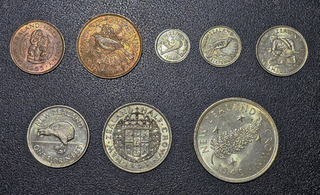
The first coinage of the New Zealand pound was introduced in 1933 in response to large-scale smuggling of prior British imperial coinage after devaluation of New Zealand exchange rates relative to the pound sterling and large influxes of other foreign coinage into circulation. The Coinage Act, 1933 outlined the weights and compositions of various denominations, out of which five silver issues entered circulation over the following year, after lengthy disagreement between rival coinage design committees. The copper penny and halfpenny entered circulation in 1940, corresponding to anniversary of the New Zealand centennial. An eighth denomination of coin, the five-shilling piece or crown, was produced solely through three commemorative issues. The first issue, the Waitangi crown, was produced in extremely limited quantities and sold to collectors. Later commemorative crown issues in 1949 and 1953 were produced for circulation.

The New Zealand penny is a large bronze coin issued from 1939 to 1965. Introduced seven years after the larger denominations of New Zealand pound coinage, the coin's issuing was scheduled to align with the centennial of the Treaty of Waitangi and the New Zealand centennial, alongside the halfpenny and centennial half-crown. Featuring the standard portrait of the ruling monarch on the obverse, the reverse features a tūī bird perched atop a kōwhai branch.

The New Zealand shilling was first issued in 1933 alongside four other denominations of New Zealand pound coinage, introduced due to shortages of comparable British silver coinage following the devaluation of the New Zealand pound relative to the pound sterling. Roughly 24 mm in diameter, it is slightly larger than the British coin it replaced. Worth twelve pence, the denomination was equal to half a florin, two sixpence, or two-fifths of a half-crown.

The New Zealand threepence is a coin of the New Zealand pound issued from 1933 to 1965. Equal to three pence, the coin was the smallest in size of all New Zealand pound coinage, and the smallest in denomination of the initial 1933 issue of New Zealand pound coinage, produced due to shortages of British silver coins resulting from the devaluation of local currency relative to the pound sterling. British artist George Kruger Gray designed the coin's reverse design after an earlier pattern design featuring a hei-tiki was rejected by a coinage design committee organised by Gordon Coates. It features two crossed patu below the label "3d". Initially struck in silver by the Royal Mint, it was struck in cupronickel from 1947 onward due to rising precious metal prices. Following decimilisation in 1967, the threepence was replaced by the coinage of the New Zealand dollar.

The New Zealand sixpence is a coin of the New Zealand pound issued from 1933 to 1965. Equal to twice a threepence or half a shilling, the sixpence was one of five denominations of silver coinage introduced in the initial issue of New Zealand coinage in 1933. Early designs for the coin featuring spears and silver ferns were rejected by committee. The coin's final reverse, designed by George Kruger Gray, features a female huia, an extinct New Zealand bird, perched atop a branch. Issued in 50% silver until a postwar rise in silver prices triggered a shift to cupronickel in 1947, the coin was minted with relative consistency until 1965, when it was discontinued following decimalisation and the adoption of the New Zealand dollar.

The half crown is the largest of five denominations of New Zealand pound coinage first issued in 1933. Introduced due to shortages of comparable British silver coinage following the devaluation of the New Zealand pound relative to the pound sterling, the coin measures roughly 32 mm (1.3 in) in diameter. It was equal to thirty pence, two and a half shillings, or an eighth of a pound.

The Centennial half-crown is a commemorative coin of the New Zealand half-crown released in 1940 to coincide with the hundredth anniversary of the Treaty of Waitangi. Designed by New Zealand artist Leonard Cornwall Mitchell, the coin features a Māori woman surrounded by both traditional and modern architecture. Although a relatively large number, over a hundred thousand, were issued, the coin was obtainable at face value and quickly disappeared from circulation.

